What will the world be like as the COVID-19 pandemic subsides? As we grapple with the impacts of this disease caused by the SARS-CoV-2 virus, business managers and policy makers need COVID-19 economic recovery forecast for post-pandemic recovery business planning.
Several things are sure:
- many activities will rebound,
- some will be permanently changed, and
- some existing trends will be accelerated
In this article Kevin Oldham draws on his research and experience in risk management to provide a perspective on possible futures for post-pandemic recovery. This post takes a global perspective, then looks at how that will likely play out in the Asia-Pacific region and finally how that may affect particular industry sectors.
Disclaimer – these are my personal views and are provided to stimulate thinking and planning for COVID-19 economic recovery. Sadly the TARDIS in the Navigatus Auckland office is non-operational so we too will have to wait to see how our close these COVID-19 economic recovery predictions turn out.
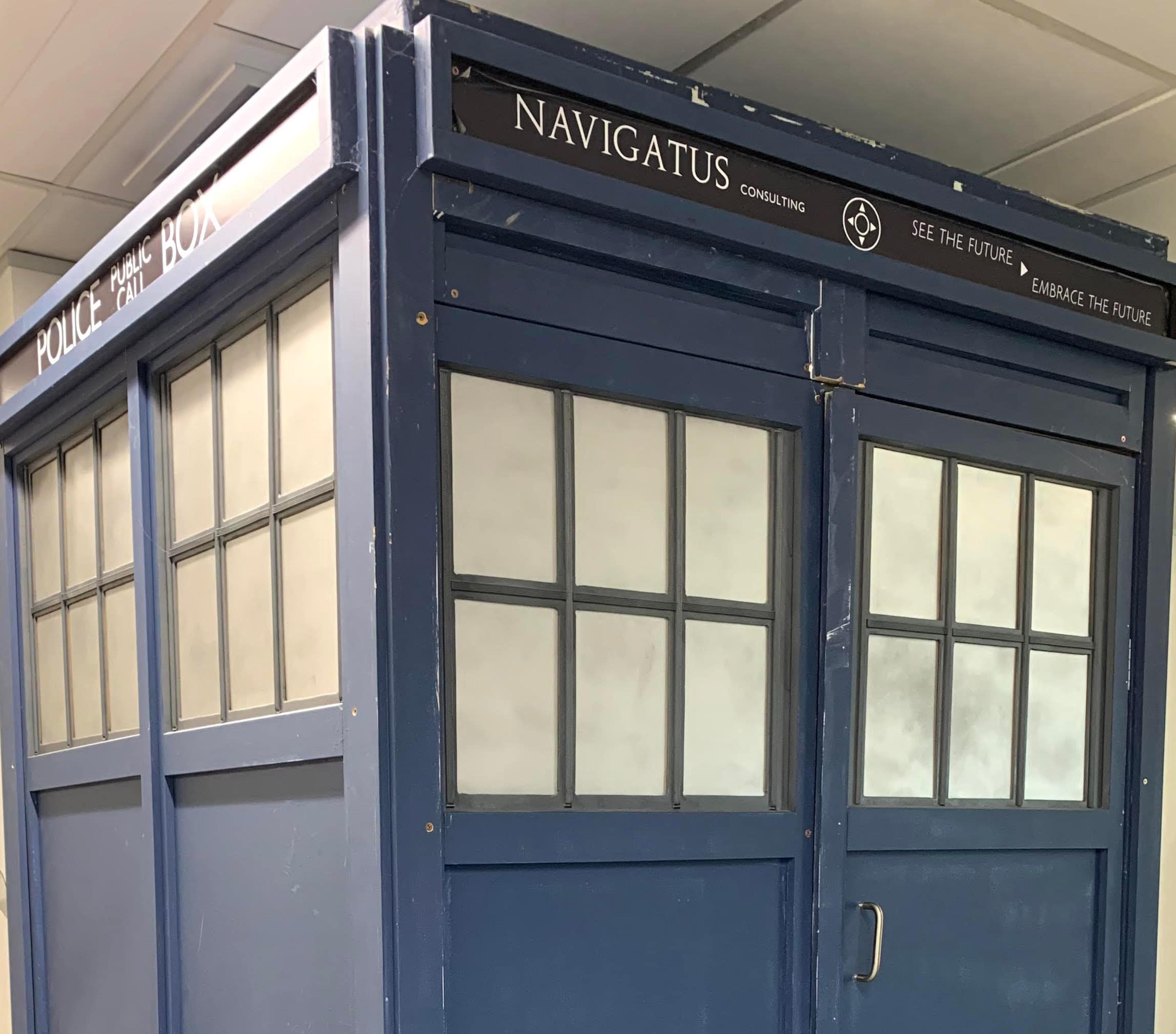
“Frozen Epidemics”
Firstly we need to understand what has happened in China. Seemingly every day China moves past a new milestone in its pandemic recovery. Life and business is swiftly returning to normal, although a bit more slowly in the epicentre of Hubei Province and Wuhan city. The World Health Organisation (WHO) is very impressed with China’s achievement, as we all should be.
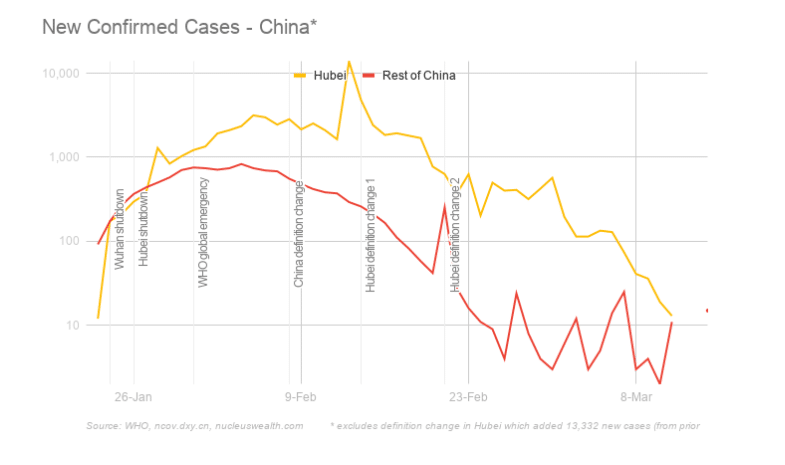
China COVID-19 new cases
In my view the most interesting insight has been from an interview reported in Vox with Bruce Aylward, the World Health Organisation (WHO) assistant director general and veteran epidemiologist who led the agency’s recent mission to China.
I think the key learning from China is speed — it’s all about the speed. The faster you can find the cases, isolate the cases, and track their close contacts, the more successful you’re going to be. Another big takeaway is that even when you have substantial transmission with a lot of clusters — because people are looking at the situation in some countries now and going, “Oh, gosh, what can be done?” — what China demonstrates is if you settle down, roll up your sleeves, and begin that systematic work of case finding and contact tracing, you definitely can change the shape of the outbreak, take the heat out of it, and prevent a lot of people from getting sick and a lot of the most vulnerable from dying.
Aggressively following up contacts and widespread testing of contacts and suspected cases have also been at the core of the successful responses in, South Korea, Taiwan, Hong Kong and Singapore. These Asian nations have seemingly well on their way to overcoming their outbreaks.
Well it’s not actually over, it’s simply in deep freeze.
An epidemic is like a chain reaction. It can be stopped. But a new infection, if undetected, could cause the chain reaction to restart and for the disease to run away through the population. If that happens then all of the efforts to stop it, at huge cost to the economies of those nations, will have been for naught. Once the disease is exterminated it can be reintroduced by travellers. So those countries need to keep on guard and be prepared to stamp out any flare-ups.
It seems that the price of success is eternal vigilance.
That’s going to make these nations very wary of reimporting the disease. I believe that these “frozen epidemics” and perhaps a few nations who succeed in preventing it gain a foothold it out will shape how the world rebounds from this crisis.
Western Nations
Elsewhere, the initial response in Japan, Europe and the US have been characterised by:
- initial messaging suggesting complacency and fatalism
- low levels of testing for the SARS-CoV-2 coronavirus in suspected cases
In the UK officials have talked of “herd immunity“. That’s a phrase that is more often used to explain how vaccination works – if say 90% to 95% of the population gets vaccinated then the disease is unlikely to be self sustaining. Those who can’t be vaccinated for medical reasons, or are unwilling to be vaccinated, are protected too as there are not enough victims to sustain an epidemic. The same happens if most people catch the disease and are naturally protected against reinfection by the antibodies that their immune system develops in response. That’s why epidemics die out.
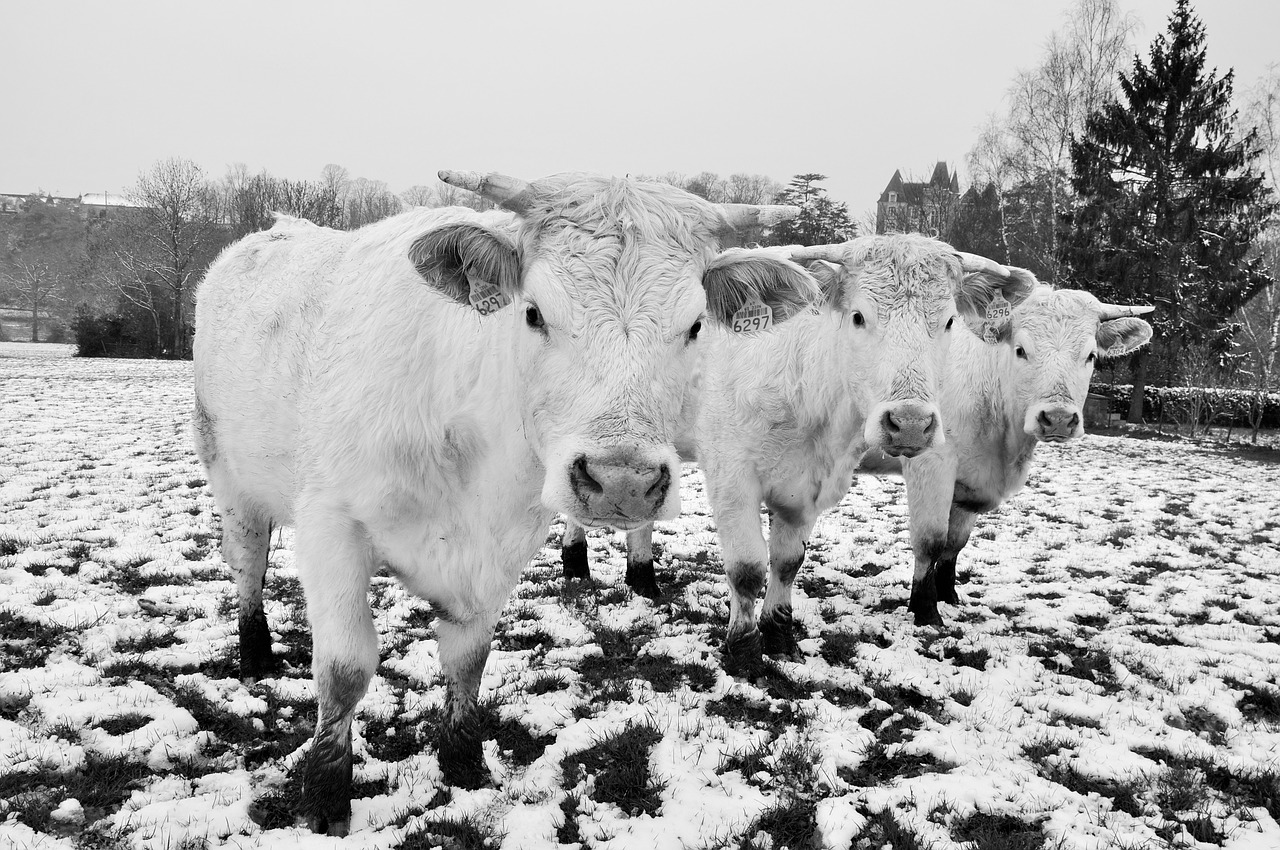
Such talk of “herd immunity” implies acceptance that most young people are going to get COVID-19 disease, which may protect the more vulnerable groups if those groups can successfully isolate themselves until it passes. The UK official’s “central estimate” is reportedly 100,000 premature deaths if 80% of the population is infected. The rapidly escalating obituary pages in Italian newspapers provide a preview of what this looks like. Perhaps this is realistic and responsible way to prepare the nation for what may now be inevitable. Perhaps a cold-blooded assessment is that the economic damage and consequent suffering from of over-reaction to the epidemic exceeds the human toll of a disease which mainly afflicts the elderly and compromised? To put the numbers in context, 531,000 people died in the UK in 2019, mostly of natural causes.
How are western nations doing in their responses? An insightful analysis of COVID cases in western nations in the first week if March, prepared by the Financial Times newspaper, is presented below. Like the graph above, this graph also uses a log scale on the vertical axis. That’s helpful to see the trajectory of an epidemic. Straight lines would show that the epidemic is increasing exponentially, doubling in scale every few days. If control measures were having an effect then these lines will be seen bending over towards the horizontal, starting from 5-7 days after the control measures take effect. For the epidemic to be fully under control the line needs to bend over fully and become horizontal – before the epidemic naturally runs out of victims.
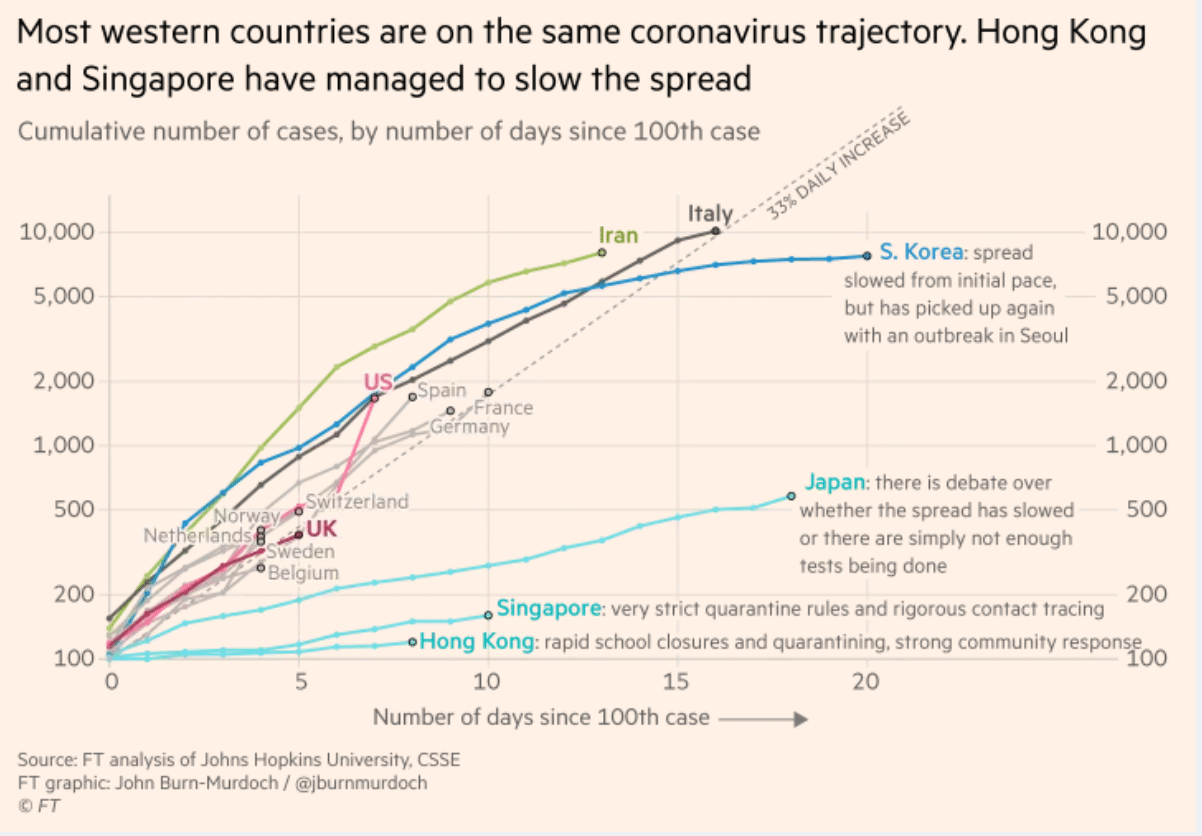
Coronavirus epidemic trajectories.
I take several lessons from this analysis:
- many western countries are on the same trajectory. Italy is about a week ahead of most European countries, while the UK appears to be less than a week behind.
- the effectiveness of control measures put in place in Western countries up until early March was low
- controls in South Korea, Singapore and Hong Kong appear to have been effective
As the death toll mounts, and China’s example shows what can be done, unfavourable comparisons are inevitable. Recently there have been an escalating series of nationwide lockdowns put in place as these countries respond to the unfolding crisis.
This all comes at great economic cost. Time will tell whether such measures alone are as effective as in China. The lesson that Bruce Aylward brought back from China is that the social distancing due to enforced lockdown is only part of the process. Speedy tracking of contacts, widespread testing and isolation of those contacts are also essential.
COVID-19 is also spreading through the US. While the nation has enviable medical skills and research capability, the lack of universal healthcare, inability to take sick days in the gig economy and a culture of individualism will present huge challenges.
It remains to be seen if the epidemic can now be stopped in its tracks in western countries. Even if it only “flattens the curve“, putting less strain on health services, that will save many lives.
The Pacific
From their place on the edge of the world, the larger Pacific nations of Australia and New Zealand are imposing tough mandatory 14 day self isolation periods. In New Zealand’s case there has clearly been a sense of responsibility to our smaller Pacific Island neighbours. In 2019 measles, presumed to have arrived from New Zealand, swept through Samoa, leading to 83 deaths.
Given the low number of cases to date, New Zealand has a chance of preventing COVID-19 from taking hold. That’s if the disease hasn’t taken hold already. To date COVID testing has been heavily restricted to cases that are likely to have come from overseas, so it’s no surprise that no cases of local transmission have been detected. Like Japan in the graph above, the number of New Zealand confirmed cases seems a lot lower than expected given our former levels of connectivity with the world. Both Japan and New Zealand have very low rates of COVID testing. The best case is that there is no iceberg of infections circulating undetected in these communities. Authorities in both countries will be hoping so.
The short term effect on tourism has been immediate and precipitous. However this recent change by the New Zealand government to a much more proactive stance, if not too late, may also contain the seeds of recovery.
The “Shanghai Free-Travel Zone”
A domino effect is occurring as a cascade of nations close their borders. Soon many other nations will have imposed their own self-isolation periods. That will put international travel into a deep freeze, with passengers numbers staying heavily depressed for months and possibly well into 2021. Airlines will struggle for survival. National flag carriers will likely be propped up by their governments. Already some airlines are putting 90% of staff on leave.

Finding the path through a frozen landscape
Governments everywhere will be anxious to minimise the damage on economies by limiting restrictions to the flow of people not goods. So how do we collectively move out from under these travel restrictions? I expect that it will be a bit like the gradual relaxation of visas for travel, granted on a nation -by-nation basis, perhaps bilaterally. Some nations, where the virus becomes endemic in the population, may never get the restrictions wholly lifted and will be bypassed.
Free -travel agreements – enabling travel free of isolation restrictions – will become the new focus of diplomacy – the modern equivalent of free-trade deals.
I expect that the lifting will start bilaterally such as China and Singapore, which might be dubbed the “Shanghai Free Travel Zone”. Other groups may form. If both Australia and New Zealand succeed in containing the disease they might quickly recognise each other as disease-free and eliminate border controls – within a few months.
With tourism being New Zealand’s biggest export industry and China being New Zealand’s second largest tourism market, we can expect that New Zealand will be striving to be do an early free-travel deal with China. The economic pressures are immense and it’s an election year in New Zealand. I expect that in the second quarter of 2020 New Zealand will unilaterally recognise China and some other Asian nations as having adequate control of the SARS-Cov-2 virus and will open the nation’s borders to nationals of those countries on direct flights.
For the lifting to be effective those same countries will also need to recognise NZ as having a sufficient level of prevention and control of COVID outbreaks to not require isolation on return. This is needed for confidence of travellers to book. That’s another reason why the recently imposed self-isolation barrier is critical to post-pandemic recovery of New Zealand as a tourist destination.
This might reshape the air route landscape, opening up new direct routes to new locations where the two nations mutually recognise each other as COVID-controlled. South Korea may be an early example of that, possibly in the third quarter of 2021.
Europe will initially struggle to enter a free travel zone due to its high level of local virus spread and due to its porous borders with regions where many diseases are poorly controlled. The substantial impact and ongoing cost of dealing with virus outbreaks may see European border policing substantially strengthened, with more funding from the central budget to the states on the front line. Meanwhile Europe’s Shengen free travel zone, already suspended by emergency travel bans, may never return in quite the same form.
Poor countries will be hurt most
Those nations that can’t control the spread of the SARS-CoV-2 virus will likely become backwaters on the other side of the isolation barrier. Such barriers will likely be whittled back somewhat – such as by recognising a recent medical test certificate to avoid isolation. However the barriers will likely remain in place until either effective vaccines are developed. In much of the world COVID may move into the background as part of the normal disease burden, much like the seasonal flu is regarded now.
As the post-pandemic world rearranges into distinct camps, populations in many poorer countries will find themselves on the wrong side of the COVID firewall. That will have heavy impacts on cultural exchange and tourism.
With the cut-off of tourism flows economies in poor countries will suffer. Tourism has been accused of contributing to climate change by movements such as Flygskam, and rightly so. But I expect that pre -2020 will be looked back upon as a golden age when tourism provided a rationale for local environmental protection and helped sustain millions in our least developed nations. It will come back but that might take years.
Great secular trends will resume
Given that we’re in the terminal stages of the longest economic expansion (in US history at least), this pandemic may be the event that sets off a sharp and deep recession affecting all businesses. The initial market reactions certainly point that way. However market sentiment is fickle and is not the best indicator of the longer term future.
Expect that the great secular trends of our time will resume:
- demographics – populations in developed countries will continue to get progressively older
- cost of capital – global interest rates will be very low , especially as central banks act to stimulate economies
- globalisation – the competitive drivers to move manufacturing or goods to lower cost centres in Asia and elsewhere will continue
- decarbonisation – continued declines in costs of renewable generation and storage will lead to increased electrification of economies
Some trends will be accelerated
Chief amongst the trends that will accelerate is working from home. Enterprises will be forced to work from home and some will find that it works rather well. Several centuries of the custom of working in office blocks won’t evaporate overnight, and offices will still be required. Only we will collectively come to realise that we don’t need everyone in the office every day. This has significant knock-on effects for everything from public transport planning to commercial property owners.
The future of cruise
I expect that the cruise industry will bounce back, but it in a slightly different form and somewhat subdued at first.
No government wants a repeat of Japan’s Diamond Princess saga on its doorstep. I expect it will be a new requirement that cruise ships have expanded and better equipped facilities to quarantine patients. There will also be an expectation that they will screen passengers and will effectively deal with their own quarantine cases on board.
The hiatus won’t be long: both the cruise industry and the local ground tourism industries rely on each other too much. I expect rebooting tourism will be a key focus of some government efforts to stimulate post COVID-19 economic recovery. Passengers will need to be coaxed back on board, but I’m confident that the cruise lines marketing teams are up to the task. Expect deals of a lifetime that will be too good to pass up. I expect to see cruise ships returning to Australia and New Zealand waters, and possibly other South Pacific destinations from early 2021 as the post COVID-19 economic recovery strengthens.
Opportunities
The two vast and obvious opportunities are in vaccines and testkits. Whoever produces a safe, effective and reliable vaccine will encounter very high demand.
Development of a safe, effective and reliable vaccine is the best possible outcome for the world economy. Many groups are working on such vaccines. However, given the large number of diseases that don’t have effective vaccines after decades or research, this is not a sure thing.
Also a single shot may not last as coronaviruses tend to mutate quickly. The the reason why vaccines for the common seasonal flu, another coronavirus, are updated each year.
The global market from governments, companies and individuals for a vaccine will be worth many billions of dollars annually. The only problems will be ramping up production fast enough and coercive IP arrangements as governments act to create access for their populations without recourse to the niceties of normal rules of commercial engagement.
Likewise, a test method that reliably and quickly diagnoses whether a person has the SARS-CoV-2 virus will have a huge market, worth billions of dollars – even if it’s pricey.
Due to lower passenger demand, air services have been sharply curtailed. We’re already seeing airlines are scrambling to cut their costs to the bone. Air cargo capacity on passenger services has also consequently limited. But air transport is critical to the global distribution of some classes of goods. Expect some passenger aircraft to be converted to freighters to run on these routes.
Winning Strategies
Not all businesses will survive, but the survivors will find a post-pandemic landscape with fewer competitors. Now is a time for planning bold moves for COVID-19 economic recovery at the business level. Enterprises that thrive will be those who use their own COVID-19 economic recovery forecast to put in place winning strategies and avoid the pitfalls. There will be a tomorrow, with a fresh landscape to survive and thrive in.
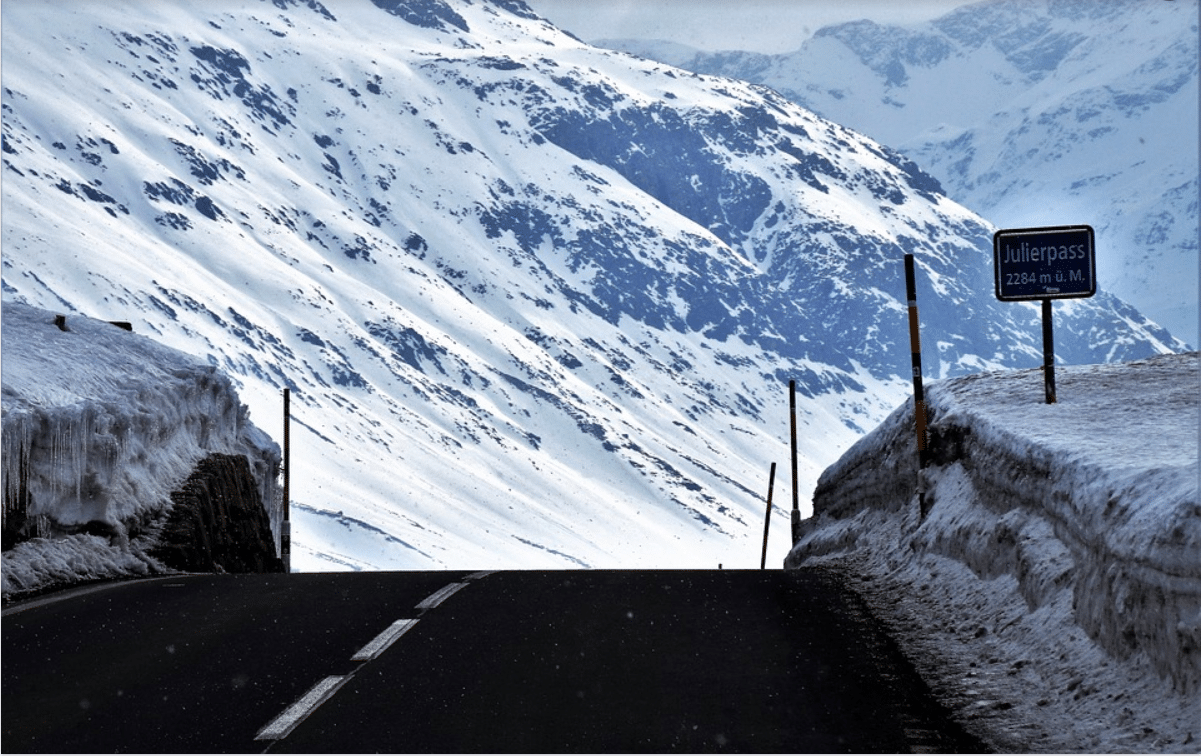
Over the pass
About the Author – Kevin Oldham
Kevin Oldham is a director of Navigatus with a depth of experience in helping clients to achieve success in an uncertain context. A brief profile for Kevin can be found here.

Comments (1)
Insightful view of the future - particularly the future of global population movement and tourism. Thanks Kevin